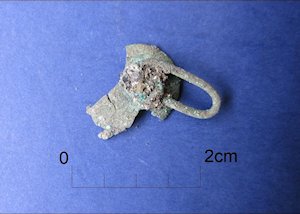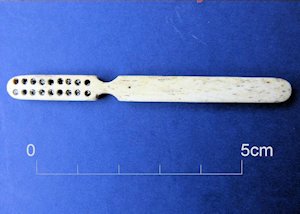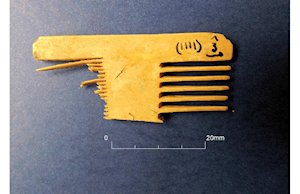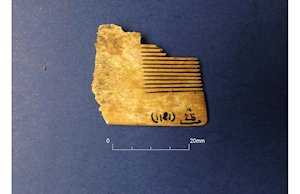
Cite this as: Newns, S. The Small Finds in N. Corcos et al. Excavations in 2014 at Wade Street, Bristol - a documentary and archaeological analysis, Internet Archaeology 45. https://doi.org/10.11141/ia.45.3.6
A total of forty-four objects, classed as small finds, were retrieved during the project, largely of metal, bone, wood and glass. Each was weighed, sketched, and its details were entered on standard pro-forma Avon Archaeology Limited recording sheets. For identification and dating purposes, objects were compared with examples from similar assemblages, such as those retrieved during the Shapwick Project (Gutiérrez 2007a; Viner 2007), and comparanda were also obtained from The Journal for Post Medieval Archaeology, Bristol and Avon Archaeology and Oxoniensia, and from object-specific publications such as Spink (2000) on coinage, and Read (2010) on early buttons. As might be expected from the location, the objects are primarily of a domestic nature, and largely date to the later post-medieval or modern periods. With the exception of a fragment of a possible 18th-century thermometer or barometer, the majority of the finds are familiar from similar urban excavations. The metalwork includes copper-alloy coins, pins, thimbles and buttons, as well as iron objects such as door/window fittings, a horse-shoe, and miscellaneous iron fittings. The thermometer/barometer (see Appendix 4) is probably the most unusual and also one of the earliest items in the assemblage, but also of note are a possible 19th-century cuff-link fragment, a billhook, and two worked bone comb fragments, the latter possibly among the earliest finds of the assemblage. Many of the small finds were retrieved from just three contexts; the fills of post-medieval cellars within Areas A and B, and from a possible cess-pit within Area A.
The finds are listed and described fully in the Small Finds Catalogue.
Owing to its relatively small size, and the fact that several of the objects are of composite materials, the assemblage is discussed under object type, rather than material category.
Probably the most interesting of the small finds is the fragment of possible thermometer (SF 33) retrieved from the secondary fill of the small cess-pit in Area A (Figure 42). This was found within an assemblage including 18th-century pottery and copper-alloy buttons (SFs 20-22). This artefact is fully discussed in Appendix 4 of this report. It is worth noting, however, that 19th-century census information (Appendix 4) has enabled us to trace a 'druggist', living at 20 Wade Street (Figures 8 and 21), in 1851, so it is just possible that at least some of the above items may have been related to the latter individual.
Five buttons, three of shell, one of bone/horn/copper alloy composite and one button back of bone/horn were retrieved during the excavation. The three shell buttons (SF nos 7, 8 and 42) are of 'mother of pearl' (oyster), of a type commonly manufactured in Birmingham in the 19th century (White 1977, 71-5). Two were retrieved from the cellar in Area B, from a levelling deposit (1138) underlying the brick floor surfaces, and one from the backfill of a nearby cellar on Swan Court (Context 184).
The one composite button (SF 17) was retrieved from the fill of a probable 18th-century cess-pit (Fill 1094) within Area A, and is composed of a domed, lathe-turned horn or bone front, with four perforations, and a copper-alloy backing, heavily corroded, with no visible attachment loop. No exact parallel has been found for this button, but its form resembles the composite metal example shown in Read 2010, and dated to the late 16th/17th century (Read 2010, 111, no. 455). Horn buttons, too, were produced in Birmingham on an industrial scale from the mid-late 18th century (White 1977, 73-4), but White also notes that carved horn buttons were produced from the early 18th century onwards in most of the larger urban centres (White 1977, 73). The fifth button (unstratified) is probably the back of a two or three piece button, and consists of a circular perforated disc of bone or horn, lathe-turned (SF 28; see Cox 1996, 54).
Two corroded button-shaped discs (SFs 20 and 21), of probable copper alloy, heavily mineralised, were also retrieved from the cess-pit fill (Context 1094). It is likely that these discs, also, are heavily corroded buttons.
One small, domed fragment of copper alloy, with attached loop junction (SF 11) was retrieved from the cellar in Area B (Context 1138) and has been identified as a cufflink fragment (Figure 70). Cufflinks first became fashionable from the late 17th century (Read 2010, 128), but Cox suggests that their use peaked in the 19th century, when the turn-back cuff largely replaced the single, starched cuff (Cox 1996, 56).

The same context (1138) within the cellar, Area B, also yielded two worked bone toothbrushes (SFs 4 and 5), one a child's brush, complete apart from the bristles (Figure 71), and the second an adult-sized brush, with head missing. The adult brush is an elongated ovoid shape, slightly curved, and has the provenance, 'LONDON', stamped on the upper face. Bone toothbrushes were being manufactured commercially in this country by the late 18th century (Marcia Cosby, pers. comm., Kent Brush Co.), and their use continued until the early 20th century, on the introduction of injection plastics, such as Bakelite (see below). The example from the Shapwick assemblage, also a bone handle, dates from the late 18th/early 19th centuries (Gutiérrez 2007b, 796, B22). An illustration in a mid-20th century encyclopaedia (Auge and Auge 1940, 135) shows an adult toothbrush of identical form to that retrieved during the excavation at Wade Street. Excavated examples from Oxford of early to mid-19th century date show grooves, similar to those on the adult brush, for locating the wires to hold the bristles in place (Egan and Henig 1984, fig. 39). In Bristol, excavations at Welsh Back yielded a bone toothbrush (without copper wiring) of early 18th century date (Burchill and Davis 2009, 37).



Two fragments of worked bone combs (SFs 3 and 25) were retrieved during the excavation, one from the fill of a ditch terminal sealed beneath flagstone surface (1184), Area C, and the second from one of a series of dump layers butting against Wall 1043, Area B. The fragments are from similar styles of comb, both double-sided, with fine teeth on one side and coarser teeth on the other. In profile, SF 3, the more complete example, tapers to either side. Neither comb is complete in terms of length, but it is likely that both combs would have originally resembled the example retrieved during the Shapwick Project, which dates typologically to the 16th/17th centuries, but was recovered in association with material of late 17th/early 18th century date (Gutiérrez 2007b, 795). Both fragments are likely to be of 18th century date (Dr Steve Ashby, pers. comm. July 2014). Similar bone comb fragments are frequently recovered during excavations in Bristol – a total of eight having been recovered from excavations at Upper Maudlin Street, and one, of late 17th/early 18th century date from excavations at Welsh Back (Burchill 2002, 103; Burchill and Davis 2009, 37).
Four copper-alloy pins and three pin fragments (SFs 2, 16, 19 and 27) were recovered during the excavation, from within the fills of foundation cuts for Walls 1012 and 1092, from within stone spread (1095), Area A, and from Context 1098, Area B, which sealed a redeposited alluvial deposit (Context 1115, see below). The more complete of the pins (SFs 16 and 27) had spherical, possibly wire-wound heads, of a type common in post medieval contexts (see Cox 1996, 55, 57; nos 17-20; Whatley 2007, 66).
Two thimbles were retrieved during the excavation, one smaller and copper alloy (SF 6) and the second larger and likely to be of copper alloy/iron composite (SF 31). Both were retrieved from levelling deposits within the cellar, Area B. The smaller example is a straight-sided, machine-made thimble, constructed from one piece of sheet metal, with machine-applied, regular pits, a domed top and a beaded rim, of a common type first introduced in the 18th century (Allen 2008, 15.2.65). The second thimble is a larger, more unusual and robust example, considerably heavier, made from iron, with some possible copper-alloy content. Corrosion obscures the sides and top, so the pits and their patterning do not survive. With a height of 26mm and maximum diameter of 20mm, it is possible that this thimble was designed to be worn on the thumb, and was for heavier duty work, e.g. that involved in the hat-making industry (see census information, Table 5:).
Two spoons were recovered during the excavations, one base metal (SF 12; see Cuddeford 1994, 46-7), retrieved from the backfill within the cellar in Area B, and one unstratified example of a base-metal spoon, electro-plated with hallmarked silver (SF 40). The hallmark suggests that it was manufactured in Birmingham, by a company established in the late 19th century. Perhaps surprisingly, no other tableware (knives, forks etc.), was retrieved during the excavations.
Two stone marbles (SFs 10 and 34) were retrieved from deposits (1123) and (1138) within the cellar in Area B. It is not known whether they would have originally started life as stoppers for 'Codd' lemonade/soda water bottles, or were, from the first, designed as toys. Codd's patent of 1870 suggests that glass was the preferred material for the manufacture of the bottle-sealing balls, although it is possible that stone was also used, particularly after the expiry of the patent in 1884, when the manufacture of this type of bottle was taken up by several other companies (Talbot 1974, 50). The Codd bottle itself continued in common use until the late 1920s (Talbot 1974, 54).
Six of the small finds recovered during the excavation can be loosely classed as household fittings, objects forming part of the internal structure or décor of the houses previously standing on the site. These ranged from a possible Bakelite finial/light-pull fitting (SF 24) to a short length of lead pipe (SF 13). Three of the items were retrieved from the deposits within the cellar in Area A, and three from deposits within the cellar in Area B.
The three household fittings/structural items retrieved from the Area A cellar comprise a large iron strap hinge (SF 14), of unknown date, from a door, a modern aluminium/chrome-plated door handle (SF 35) and the aforementioned possible Bakelite light-pull/finial. The finial has an internal screw thread, and external stylised foliage moulding. If the object is composed of Bakelite, this would give it a probable date of 1928 onwards, when the Birmingham Bakelite factory started production (Wikipedia, site accessed August 2014).
The three structural items retrieved from the cellar in Area B comprise a small, irregularly shaped hook (SF 9), made from copper-alloy wire, such as might be used for a catch on a cupboard door, a length of iron bar (SF 30), tapering at one end, with a perpendicular circular plate at the other, possibly forming part of a hinge for a window, and the aforementioned lead pipe, composed of a rolled sheet of lead, possibly forming a collar at the end of a length of pipe.
Only two coins were retrieved during the excavation, both from Area A, one (SF 23) from the upper fill of the backfilled cellar adjacent to Little Anne Street (Context 1060) and one (SF 26) from the fill of the cut for a metal water pipe (Context 1035). The earlier coin (SF 26) is a Victorian bronze farthing, dated 1873 (Spink 2000, 405, no. 3958). The later coin is a sterling silver half-crown of George V, dated 1915 (Spink 2000, 416, no. 4011).
It is possible that a flat, circular copper-alloy disc (SF 22), retrieved from the probable cess-pit in Area A, may also be a coin, but the disc remains to be identified.
An iron billhook blade (SF 43) was recovered, unstratified, during the watching brief, but was not retained. The blade was heavily corroded, but retained an iron tang, and was of similar overall dimensions to an 18th/19th century example retrieved during excavations at Upper Maudlin Street, Bristol (Burchill 2002, 101). Billhooks, although primarily used nowadays in hedge-laying, would have formerly been utilised in a number of other crafts such as hurdle making, spar making, besom broom making and basket making (http://www.billhooks.co.uk). Less specialised uses would also have included splitting kindling wood, in the preparation of faggots that could then be sold for fuel. Examination of census returns for the surrounding streets (see Appendix 1) has shown that, between the years 1851 and 1911, the numbers of those involved in cutting and selling firewood varied, for most years, between one and four, with an unexplained peak of twenty-five individuals in the census for 1871, which also corresponds to a peak in the overall population of the immediate area. 33
A fragment of folding wooden ruler (SF 1), with a brass sleeve around the hinge and a corroded iron pin was retrieved from Deposit (1123), within the cellar in Area B. The ruler is in a highly fragmentary condition, but it is just possible to discern markings at 1/16ʺ intervals. The ruler is undated, but similar examples are still in use today.
A worked bone off-cut (SF 18) was retrieved from the fill (Context 1048) of the foundation cut for Wall 1047, Area B. The remaining fragment (now missing) is rectilinear, and it is not known whether the bone would have been truncated in this way during a manufacturing process, or during butchery (see Appendix 6).
Nine miscellaneous small finds were retrieved, six of iron, one of copper alloy and one of wood. A small L-shaped fragment of copper-alloy sheet (SF 29) with a single, sub-circular perforation, was retrieved from Context (1115), observed at the base of the sondage through the cobbled surface in Area A, and possibly one of the earlier deposits recorded on the site. The metallic fragment is likely to be either an off-cut from metal-working, or to have formed part of a larger object.
Immediately below the same cobbled surface (from Context 1091), excavation revealed a large, slightly irregular octagonal iron washer, or perforated plate (SF 38).
Four miscellaneous iron objects, comprising three iron strips (possible barrel hoop or strap hinge fragments, SF 36) and a tapering iron spike (SF 15) were retrieved from the fill of the cellar (Context 1136) within Area A.
The remaining three miscellaneous objects comprise an iron horse shoe, or boot heel plate (SF 32), from a deposit butting Wall (1075), Area B, a possible tool or machine component (SF 37) from within the fill of the foundation cut for Wall (1047), also Area B, and a fragment of irregular, split timber (SF 44; unstratified). The possible horse shoe measures less than 72mm wide, with a marked fullering groove, and may be either the shoe for a small pony, or a boot heel plate. The regularity of the form would suggest a 19th/20th century date for this object (Cuddeford 1994, 22-3).
The most unusual and interesting of the small finds (and also one of the earliest) is the fragment of glass thermometer or barometer of probable 18th century date (see Appendix 4).
With the exception of this artefact, the assemblage itself is largely unremarkable, and, in fact, contains little early material, which is, perhaps, surprising for an area known to have been inhabited from the early 18th century onwards. What is also of note is that, for an area known to have been inhabited by artisans, very few tools or objects used in craft activity were recovered during the excavations, and no knives, which are common finds on most post-medieval urban sites. What this may suggest is that items of value such as these were carefully conserved, retained in use, and, finally, removed by their owners, prior to the demolition of the buildings.
Analysis of the census material for the surrounding streets between the years 1851 and 1911 has shown a relatively consistent 10 per cent of the total population working in comparatively skilled trades. Only one of the small number of tools recovered during the excavation can be related to a specific trade, and that is the billhook, which is more than likely to have been used for chopping/preparing bundles of kindling for fuel (Jackson and Price 1974, 23; also see http://www.billhooks.co.uk). Other items, such as the folding wooden ruler, are likely to have been used in a number of different trades represented among the individuals recorded, including stone mason, carpenter, cabinet maker etc. (see Appendix 1). The same applies to the dressmakers' pins and the smaller of the two thimbles, which could have been used by the several seamstresses recorded, but which are, in fact, common finds among most post-medieval urban assemblages. Similarly, the larger and sturdier of the two thimbles may have been used in several trades among those recorded, including straw bonnet maker and hatter (Tables 4 and 5).
Internet Archaeology is an open access journal based in the Department of Archaeology, University of York. Except where otherwise noted, content from this work may be used under the terms of the Creative Commons Attribution 3.0 (CC BY) Unported licence, which permits unrestricted use, distribution, and reproduction in any medium, provided that attribution to the author(s), the title of the work, the Internet Archaeology journal and the relevant URL/DOI are given.
Terms and Conditions | Legal Statements | Privacy Policy | Cookies Policy | Citing Internet Archaeology
Internet Archaeology content is preserved for the long term with the Archaeology Data Service. Help sustain and support open access publication by donating to our Open Access Archaeology Fund.